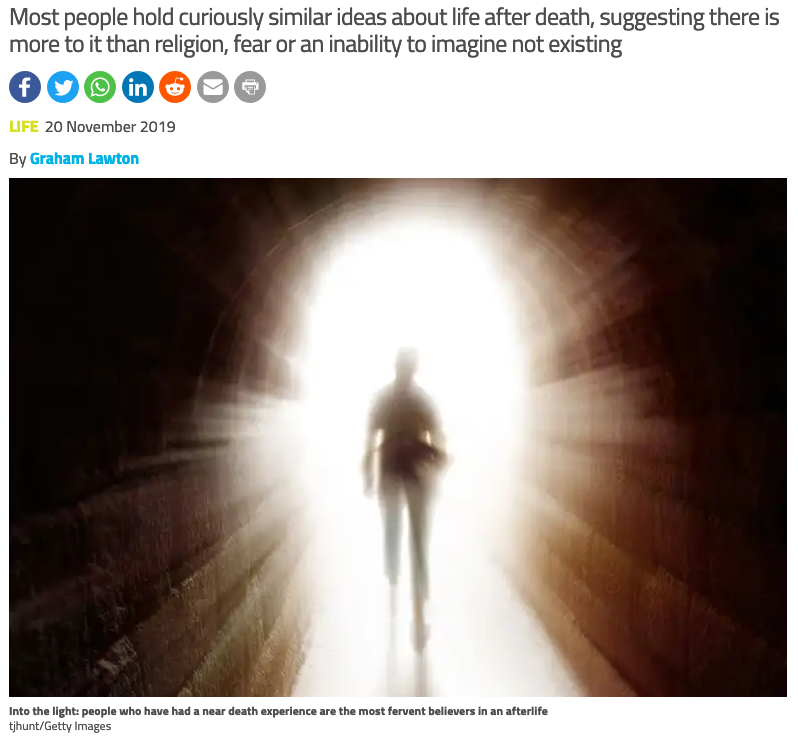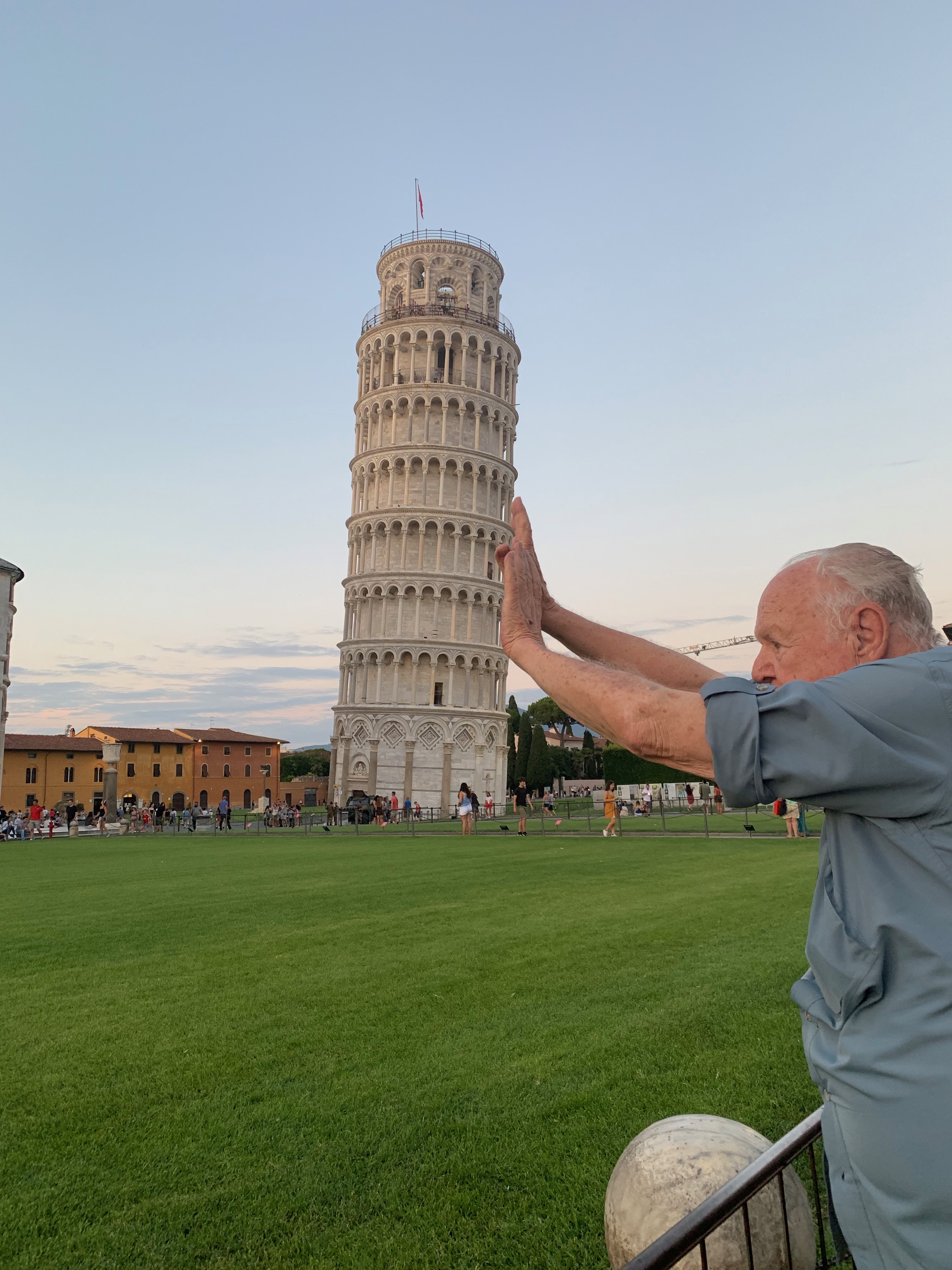
RICHARD WAVERLY was a 37-year-old history teacher. One day he was driving to work, tired after a late night and hungry from skipping breakfast. He was also in a bad mood following a row with his wife, who he suspected of having an affair. At a busy junction, he lost control, drove into a telegraph pole and was thrown through the windscreen. The paramedics said he was dead before he hit the pavement.
This story is fictitious, but when psychologist Jesse Bering narrated it to volunteers, he discovered something you probably couldn’t make up. Asked questions such as “do you think Richard knows he is dead?” and “do you think he wishes he had told his wife he loved her before he died?”, large numbers of volunteers answered yes. For many, who had already professed a belief in the afterlife, this was no big surprise. However even people who totally rejected the idea of life after death – so-called extinctivists – also answered yes.
Read more: Why the line between life and death is now more blurred than ever
That experiment was done in 2002. Since then, Bering – who is now at the University of Otago in Dunedin, New Zealand – and others have confirmed and extended its findings. Confronted with the finality of death, the majority of us, dogged rationalists included, cling on to the belief that it isn’t the end. “Most people believe in life after death,” says psychologist Jamin Halberstadt, also at the University of Otago. “That’s amazing. Science has changed the way we think about almost every aspect of our lives, including death, but through all of that, belief in life after death has remained steadfast.” Why?
Humans aren’t the only animals with an awareness of death. Elephants and dolphins are fascinated by corpses of their kin and chimps have been observed performing what some primatologists say are elaborate funerary rituals. We have no way of knowing whether they have a concept of an afterlife, but we know for sure that humans do. Archaeological evidence for afterlife beliefs goes back at least 12,000 years, when bodies started to be buried with useful stuff to take to the other side. But such beliefs are far from a thing of the past. Surveys done regularly since the 1940s consistently show that about 70 per cent of US citizens believe in some form of life after death – a number that is mirrored across the developed world. What’s more, as Bering found, even the 30 per cent who say they don’t, often do. When he asked extinctivists whether they agreed with the statement “conscious personality survives the death of the body but I am completely unsure of what happens after that”, 80 per cent said yes.
Theologically incorrect
An obvious explanation is that people internalise religious teachings. “One function of religion is to alleviate death anxiety because it usually comes with afterlife beliefs,” says Halberstadt. But that doesn’t explain why belief in the afterlife has held up even as religiosity has declined, nor why these beliefs are rarely religious. Rather than articulating concepts such as heaven and hell, they talk in vague terms about there being “something”. This lack of theological correctness has led psychologists to see afterlife beliefs as largely intuitive rather than learned.
Read more: When robots are ultra-lifelike will it be murder to switch one off?
It is partly a failure of imagination, according to Bering. Despite having been non-existent for billions of years before we were conceived, we can’t imagine being in that state after death. This might help explain a feature common to many afterlife beliefs. In the Richard experiment, for example, as well as asking about post-mortem mental states – desires, knowledge and feelings – Bering also asked about physical attributes such as hunger, pain and tiredness, and whether Richard could still see, hear and taste. People accepted that biological and perceptual abilities were lost, but maintained that psychological states persist. In other words, we can conceive of our bodies dying, but not our minds. “I can imagine not being hungry, or not being able to see, but to imagine not being anything is impossible because imagination itself is a mental state,” says Jonathan Jong at the University of Coventry, UK.
“We can conceive of our bodies dying, but not our minds.”
But, again, that isn’t the whole story. Afterlife beliefs don’t just emerge when we try, and fail, to imagine death. They seem to be a default setting of cognition. In a recent cunning experiment, Halberstadt invited students to take part in what they were told was a meditation trial. They were shown into a room and wired up to record their arousal levels. Then half of them were told that a few weeks beforehand a janitor had died in the room and that a student later saw a ghost in the corner. Halfway through, the experimenters made the light in the room flicker. People who hadn’t been told the ghost story showed mild surprise; the others – including self-proclaimed extinctivists – jumped out of their skins. This, says Halberstadt, is evidence that belief in the afterlife is instinctive and universal. Extinctivists are simply people who have learned to suppress it.
Read more: From mushroom shrouds to cyber funerals, a 21st-century guide to death
Psychologists think that these “implicit beliefs” are a by-product of our evolved cognition. One essential tool in our mental toolkit is theory of mind: the ability to think about other people’s thoughts, beliefs, feelings and intentions even in their absence. This underpins belief in gods and other supernatural beings, and also makes afterlife beliefs come easily. Even when somebody dies, we don’t switch off our theory of mind about them. “There’s something intuitive about projecting psychological traits onto people who are dead,” says Jong.
Of course, none of this tells us anything about the existence or otherwise of the afterlife. “I’m a social psychologist, so I know what people believe is totally independent of reality,” says Halberstadt. But don’t worry, you’ll find out sooner or later.
Touching the void
The vast majority of us hold some kind of belief in an afterlife, but the people who believe in it most strongly are those who claim to have been there and lived to tell the tale.
Up to 25 per cent of people who almost die report a near-death experience. These usually involve sensations of zooming through a tunnel towards a light. Many also feature replays of the person’s life and reunions with dead loved ones.
Near-death experiences may result from lack of oxygen to the brain. Whatever causes them, they tell us nothing about whether the afterlife exists. Yet their psychological effects are profound, says Natasha Tassell-Matamua of Massey University, New Zealand.
Survivors often believe they have been to another realm. They lose all fear of death and become convinced that some aspect of their consciousness will survive it – although they struggle to say what, falling back on vague notions such as spirit and soul. Even people who were convinced that death is final often come back from a brush with it as believers in an afterlife.
Read more: https://www.newscientist.com/article/mg24432570-500-why-almost-everyone-believes-in-an-afterlife-even-atheists/#ixzz66K7su9D6
